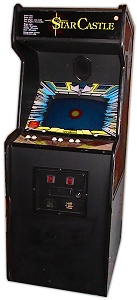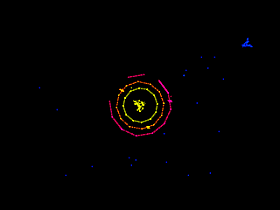 The Game: You control a lone space fighter in the immediate vicinity of the nearly-impenetrable Star Castle. Its three layers of shields rotate, but those layers aren’t solid, so you might be able to get a shot in and destroy the alien craft at its center – but it’s also just as likely that the alien will get a clear shot at you…and its firepower is far greater. (Cinematronics, 1980)
The Game: You control a lone space fighter in the immediate vicinity of the nearly-impenetrable Star Castle. Its three layers of shields rotate, but those layers aren’t solid, so you might be able to get a shot in and destroy the alien craft at its center – but it’s also just as likely that the alien will get a clear shot at you…and its firepower is far greater. (Cinematronics, 1980)
Memories: Tim Skelly’s all-time arcade classic managed to get a cult following despite being eclipsed technologically by some of its contemporaries. In order to get its three rotating shield rings to be multicolored, Star Castle relied on transparent overlays on the monitor – not unlike the TV screen overlays of the original Magnavox Odyssey home video game console – to provide that color. The monitor itself was a monochrome XY monitor, something that would soon be extinct as Atari unleased a series of  games with full-color vector graphics like Battlezone and Tempest. But one home video game manufacturer took note – the overlay concept was used for GCE’s XY-display Vectrex system…which naturally became the only place where one could play a home version of Star Castle.
games with full-color vector graphics like Battlezone and Tempest. But one home video game manufacturer took note – the overlay concept was used for GCE’s XY-display Vectrex system…which naturally became the only place where one could play a home version of Star Castle.
The game was still challenging and addictive, however – so much so that Atari quietly asked one of its ace in-house programmers, Howard Scott Warshaw, to come up with a similar game for the Atari 2600. Warshaw wasn’t able to replicate Star Castle very well, but he  was able to create a challenging new game by losing the rings and setting the enemy fortress off to one side of the screen. The result? Yars’ Revenge.
was able to create a challenging new game by losing the rings and setting the enemy fortress off to one side of the screen. The result? Yars’ Revenge.
Star Castle also has the odd distinction of being frequently seen on film. Numerous movies made Star Castle appear more ubiquitous in fictional celluloid arcades than it was in real life. Programmer Tim Skelly later credited this to the game’s bright, colorful display (which ran at 24 frames per second, just like a film camera, as opposed to most raster monitors’ 30 frame scan rate which would cause a “rolling” effect) and equally colorful cabinet.
 Skelly later moved on to Chicago-based pinball manufacturer D. Gottlieb & Co., where he secured a lucrative contract with a rare provision in its wording: his games would feature his name onscreen. His games for Gottlieb included Mad Planets and the innovative Reactor. He later worked at Microsoft, researching and designing user interfaces.
Skelly later moved on to Chicago-based pinball manufacturer D. Gottlieb & Co., where he secured a lucrative contract with a rare provision in its wording: his games would feature his name onscreen. His games for Gottlieb included Mad Planets and the innovative Reactor. He later worked at Microsoft, researching and designing user interfaces.
 The one problem with Star Castle is the necessity of the castle’s stationary position (moving the castle would’ve caused it to slip out from under the colored overlay). This was later remedied with a color vector game with a similar premise, Sega/Gremlin’s Eliminator.
The one problem with Star Castle is the necessity of the castle’s stationary position (moving the castle would’ve caused it to slip out from under the colored overlay). This was later remedied with a color vector game with a similar premise, Sega/Gremlin’s Eliminator.